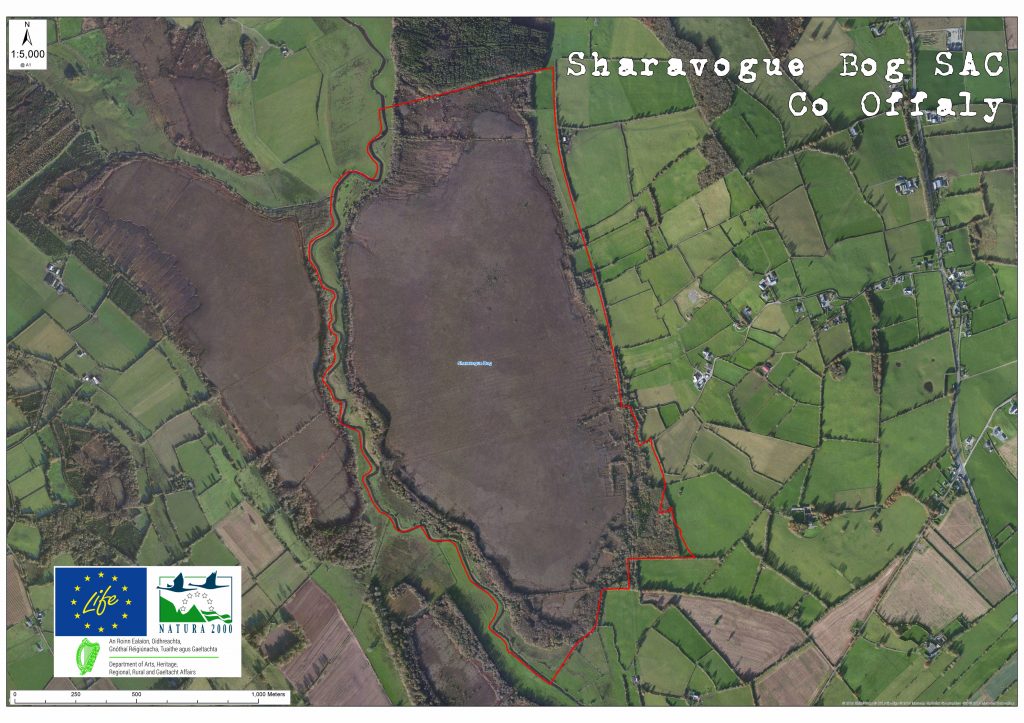About Sharavogue Bog
Situated south of the historic Offaly town of Birr, Sharavogue Bog is one of Ireland’s best preserved raised bogs. Sharavogue Bog is also one of the few remaining raised bogs in Ireland situated on a floodplain. It has a well-developed dome of uncut peat which is long and relatively narrow. Restoration prospects here are very good.
Like our Westmeath project site Garriskill, it is bounded by a decommissioned public rail line on one side (the Birr-Roscrea line, see History section) and a river on the other – and it boasts a connection to no less a person than Saint Patrick! Turf cutting here never really reached the levels it did elsewhere in Offaly, though a large section to the north of the bog was extensively cut in the early 1900’s. But the main active raised body of the bog remains and its good condition is testament to two local men who worked together to save the bog from heavy machinery harvesting in the 1990’s. Drainage channels were dug across the bog sometime in the early 1990’s and only for the actions of Mr Liam Egan and Mr Patrick Headon, Sharavogue could have been lost forever.

The total site covers 223.43 ha and is situated between the River Little Brosna and an elevated ridge of Carboniferous limestone. It includes 137 ha of uncut raised bog and 86 ha of surrounding areas which include cutover bog, wet grassland, semi-natural woodland, and an area of wet lagg vegetation in the cutover along the eastern margin of the bog. The eastern edge is bounded by a disused railway embankment, which once linked Birr to Roscrea, and the western edge by the Little River Brosna.
Restoration works here were undertaken by contractors in 2021 with over 400 dams installed. These have helped re-wet the bog, increase the areas of Active Living Raised Bog, store carbon, clean water, increase biodiversity and generally make this impressive bog an even better place than it already was.
The bog is underlain by low permeability limestone and limestone till.
The site is a Special Area of Conservation (SAC) selected for the following habitats and/or species listed on Annex I / II of the E.U. Habitats Directive (* = priority; numbers in brackets are Natura 2000 codes):
[7110] Raised Bog (Active)*
[7120] Degraded Raised Bog
[7150] Rhynchosporion Vegetation
Active Raised Bog (ARB) comprises areas of high bog that are wet and actively peat-forming, where the percentage cover of bog mosses (Sphagnum spp.) is high, and where some or all of the following features occur: hummocks, pools, wet flats, Sphagnum lawns, flushes and soaks.
The LIFE team will publish its results in late 2021, but the most recent studies from 2011 and 2002 indicated that ARB cover on Sharavogue is high, over 25.8ha of the high bog area, mainly in the central and southern part of the dome. With restoration works to be carried out on site between 2017 – 2020 we aim to increase this to over 40h on the high bog. Prospects for restoration here are positive.
Degraded Raised Bog (DRB) corresponds to those areas of high bog where the hydrology has been adversely affected by peat-cutting, drainage and other land use activities, but which are capable of regeneration to ARB within 30 years.
The area of (DRB) on the High Bog was modelled as 29.5ha (by Fernandez et al. 2012), mainly on the southern dome but it lacks many extensive areas of quaking hummock/hollow/pools as a result of long-term drying out caused by peat cutting, burning and marginal and river drainage.
Many of the drains inserted on the high bog in the 90’s and on the south eastern area of the cutover were dammed in the late 1990s as part of an E.U. Cohesion project to restore peat forming conditions. That project was successful in halting and reversing, to some extent, the decline of ARB on the site.
The Living Bog built on this work, restoring and increasing the area of Active Raised Bog by almost twice its current amount. In time, our restoration work will lead to an even bigger increase…

